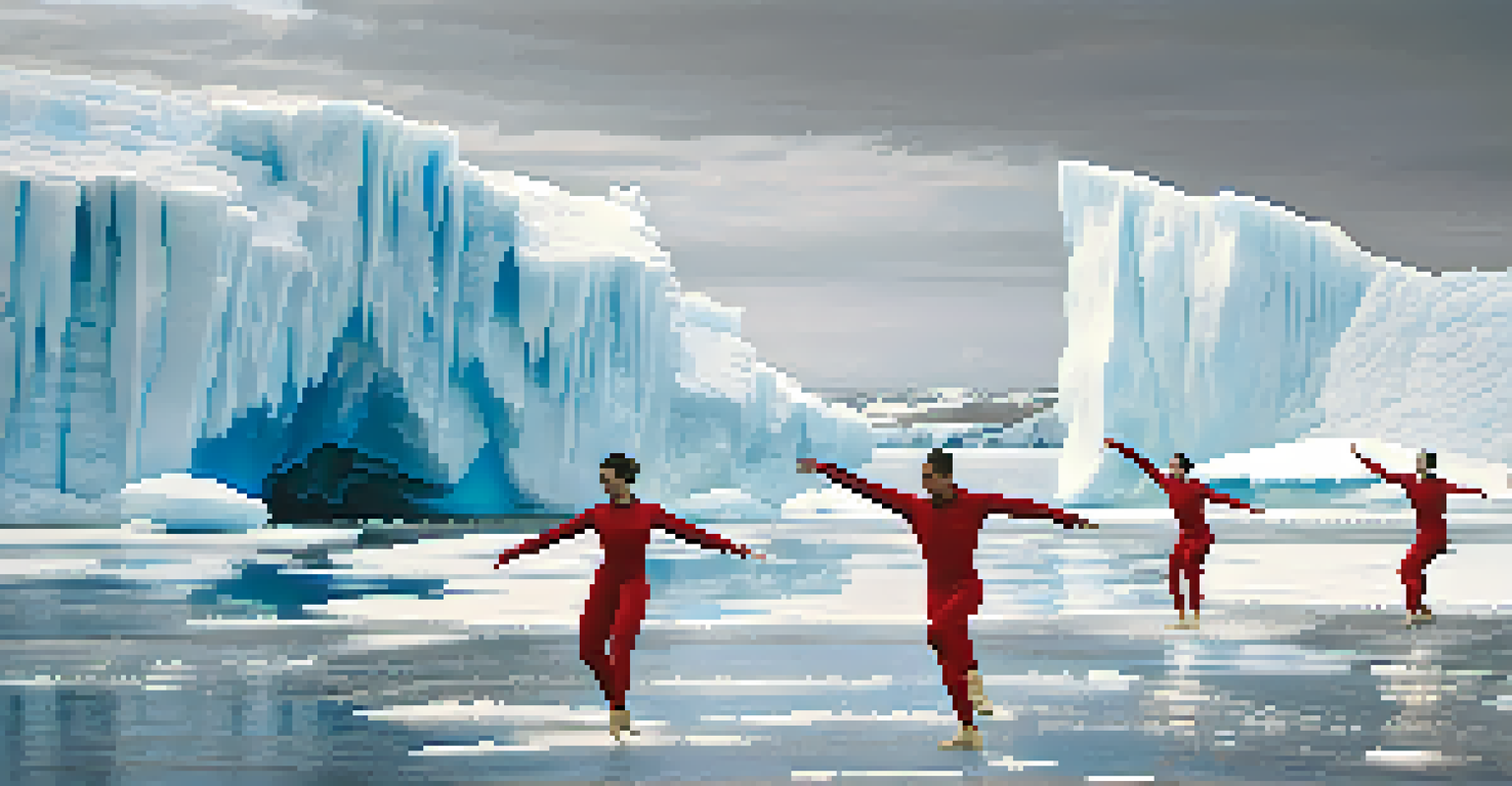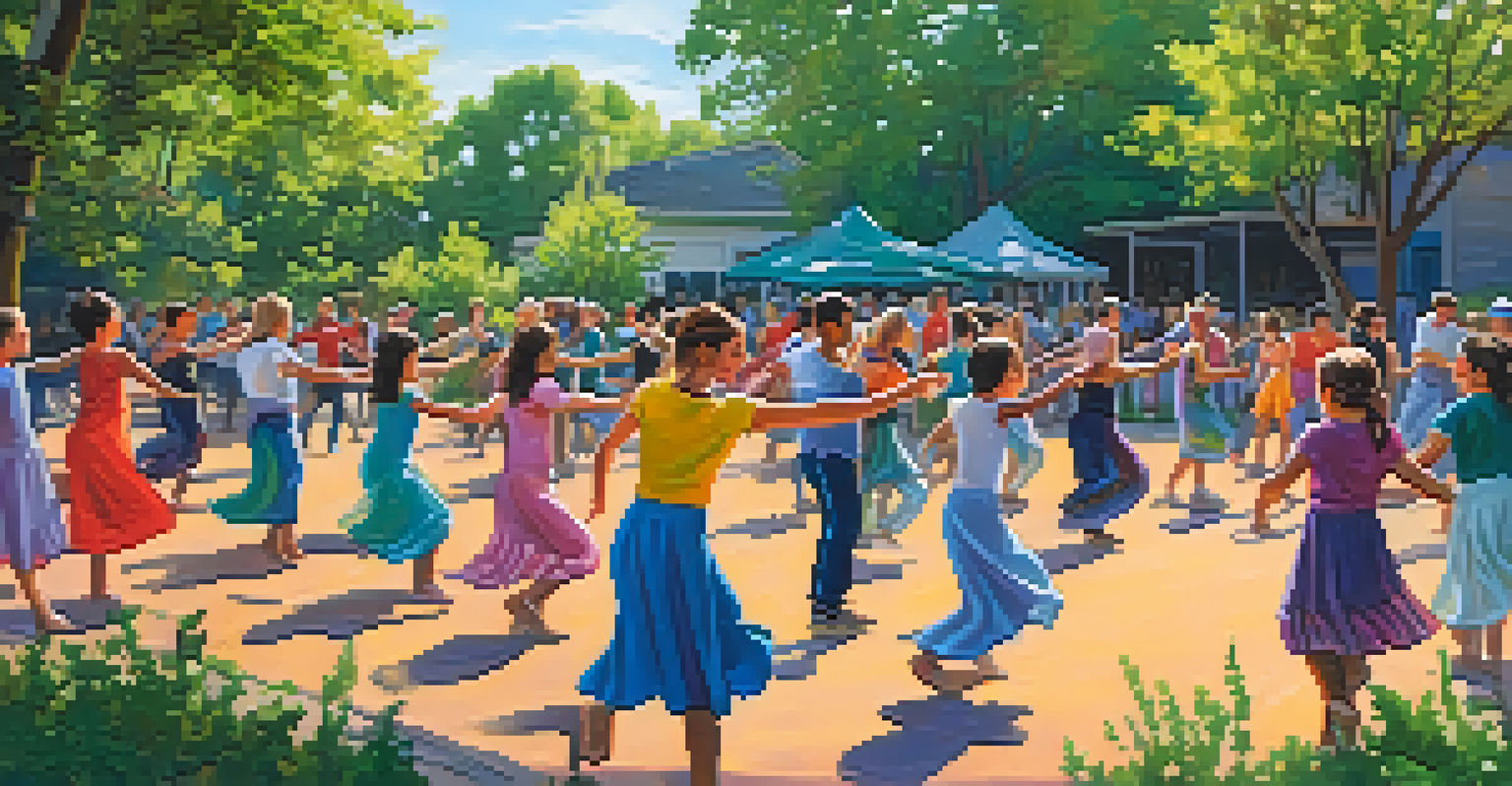Dance Movements Inspired by Ecological Challenges

The Intersection of Dance and Ecology
Dance has always been a powerful medium for expression, but its connection to ecological issues is becoming increasingly prominent. Dancers and choreographers are using movement to raise awareness about environmental challenges, such as climate change and habitat destruction. This fusion of art and activism not only captivates audiences but also encourages a deeper understanding of these pressing issues.
Dance is the hidden language of the soul.
For example, performances that incorporate themes of nature and sustainability can evoke a strong emotional response, prompting viewers to reflect on their relationship with the environment. By portraying the fragility of ecosystems through dance, artists are creating a visceral experience that words alone cannot convey. This approach bridges the gap between art and activism, making complex ecological issues more accessible.
Moreover, dance movements inspired by ecological challenges encourage collaboration between artists, scientists, and environmentalists. This interdisciplinary approach fosters innovative ideas and solutions, demonstrating how art can play a vital role in promoting ecological awareness. Ultimately, dance becomes a form of storytelling that advocates for the planet.
Movement as a Reflection of Nature
Many choreographers draw inspiration from the natural world, translating the rhythms and patterns of nature into movement. For instance, a dancer might mimic the swaying of trees or the flow of water, embodying the essence of these elements through their performance. This not only highlights the beauty of nature but also serves as a reminder of its vulnerability.

Through such movements, dancers can illustrate the impact of human actions on the environment. For example, a piece that showcases the chaotic dance of a forest fire can reflect the destructive forces of climate change. By embracing these themes, artists can challenge audiences to confront uncomfortable truths about ecological degradation.
Dance Merges Art and Activism
Dancers are using movement to raise awareness about ecological issues, creating emotional experiences that inspire audiences to engage with environmental challenges.
Furthermore, this connection to nature fosters a sense of reverence and responsibility within both the performer and the audience. As viewers witness the delicate balance of ecosystems depicted through dance, they may be inspired to take action in their own lives. This transformation of awareness into action is a powerful outcome of dance that resonates beyond the stage.
Choreography Addressing Climate Change
Choreographers are increasingly using their platforms to address climate change directly through their work. By incorporating elements that signify rising sea levels or melting ice caps, these performances make the abstract concept of climate change tangible. Such choreography invites audiences to consider the immediate effects of these global challenges.
The Earth has music for those who listen.
For example, a dance piece that features movements representing the struggle of polar bears could effectively illustrate the urgency of protecting endangered species. This approach not only raises awareness about specific issues but also fosters empathy for those affected by environmental changes. The emotional journey of the performers can resonate deeply with viewers, prompting them to engage with these issues on a personal level.
Additionally, the use of multimedia elements, such as projections of affected landscapes, can enhance the storytelling aspect of these performances. Combining dance with visual aids creates a multisensory experience that leaves a lasting impression. As audiences witness the dance of despair and hope, they are compelled to reflect on their role in addressing climate change.
Community Engagement Through Dance
Dance can serve as a powerful tool for community engagement when it comes to ecological issues. Many local dance companies collaborate with environmental organizations to create performances that not only entertain but also educate. These partnerships foster a sense of shared responsibility and encourage community members to take action.
Workshops that integrate dance with environmental education allow participants to explore these themes creatively. For instance, a community dance project might focus on local environmental challenges, enabling participants to express their concerns through movement. This approach not only empowers individuals but also strengthens communal ties, as everyone works together towards a common goal.
Nature Inspires Choreography
Choreographers often draw from the natural world, translating its rhythms into dance to highlight both its beauty and vulnerability.
Moreover, these initiatives often culminate in public performances that invite the wider community to witness the collective effort. Such events can spark conversations about environmental stewardship and inspire others to get involved. By making ecological challenges a shared experience, dance becomes a catalyst for change.
Dance as a Form of Activism
As the urgency of ecological issues grows, dance is increasingly recognized as a legitimate form of activism. Performances can serve as protests, using the body as a tool for advocacy. For example, a flash mob might gather in a public space to draw attention to deforestation, using movement to convey their message powerfully.
This form of activism not only raises awareness but also inspires others to join the cause. When audiences see dancers passionately advocating for the environment, it can ignite a spark of motivation within them. The visceral nature of dance can create a sense of urgency that written words may fail to achieve.
Moreover, social media has amplified the reach of these performances, allowing messages to spread far beyond the immediate audience. Videos of dance activism can go viral, reaching individuals who might not otherwise engage with ecological issues. This blend of art and activism highlights the potential of dance to foster social change.
The Role of Technology in Dance and Ecology
Technology plays a significant role in the evolution of dance movements inspired by ecological challenges. With advancements in digital media, choreographers can incorporate virtual reality and projection mapping into their performances. This fusion not only enhances the visual experience but also allows for a more immersive exploration of ecological themes.
For instance, a dance performance that utilizes augmented reality can transport audiences to endangered ecosystems, creating a powerful emotional connection. By experiencing these environments through dance, viewers are more likely to understand the urgency of preserving them. This innovative approach to choreography can captivate younger audiences who are accustomed to digital experiences.
Technology Enhances Dance Experience
Advancements in technology, like virtual reality and projection mapping, are transforming dance performances into immersive experiences that convey urgent ecological messages.
Furthermore, technology enables broader outreach for eco-themed dance performances. Streaming platforms allow these works to reach a global audience, making it easier to share messages about environmental stewardship. As technology continues to evolve, so too will the ways in which dance addresses ecological challenges.
Future Directions for Dance and Ecology
Looking ahead, the relationship between dance and ecological challenges is poised to grow even stronger. As global awareness of environmental issues increases, artists will continue to find innovative ways to express these themes through movement. Future choreography may increasingly reflect the urgency of climate action, incorporating real-time data and community narratives.
Additionally, we can expect to see more interdisciplinary collaborations that bring together dancers, scientists, and activists. These partnerships will not only enhance the depth of the performances but also foster a greater understanding of the complexities of ecological issues. By blending expertise from different fields, artists can create a richer storytelling experience.

Ultimately, the future of dance in relation to ecological challenges holds immense potential for positive change. As artists continue to push boundaries and engage with pressing issues, dance will remain a vital medium for inspiring action and fostering a deeper connection to the planet.